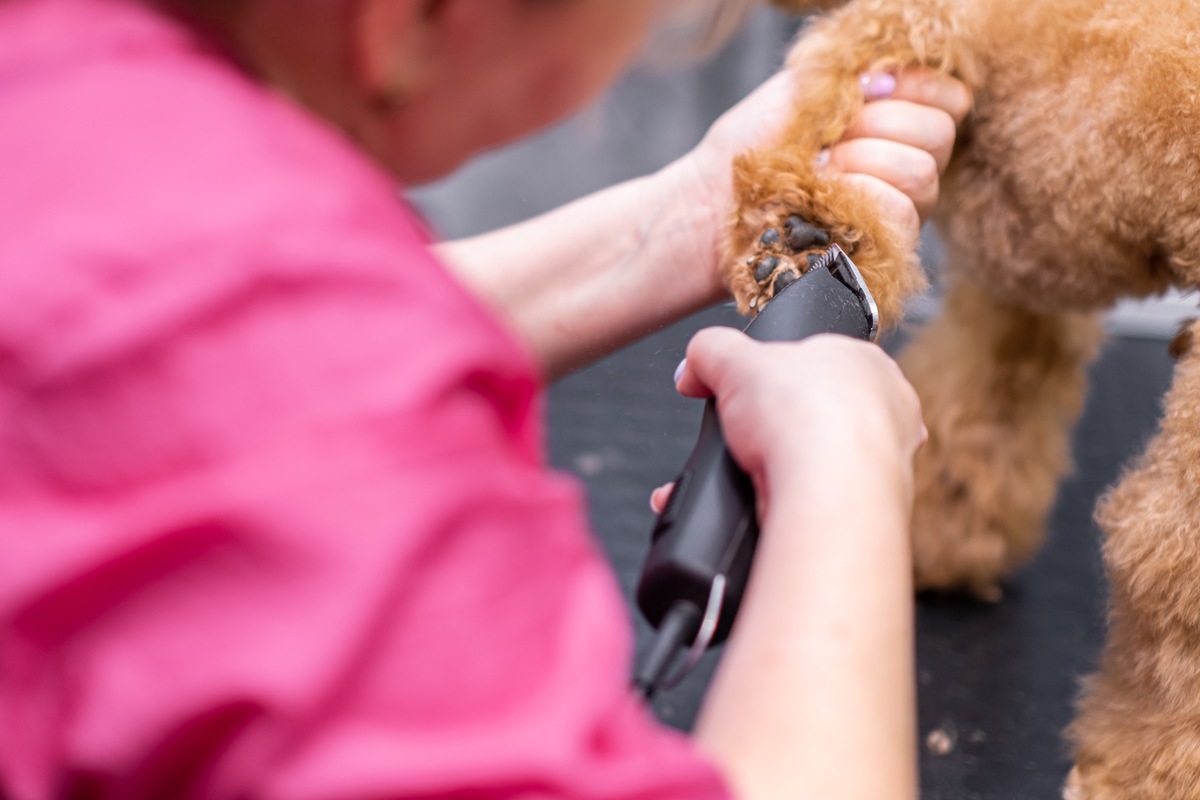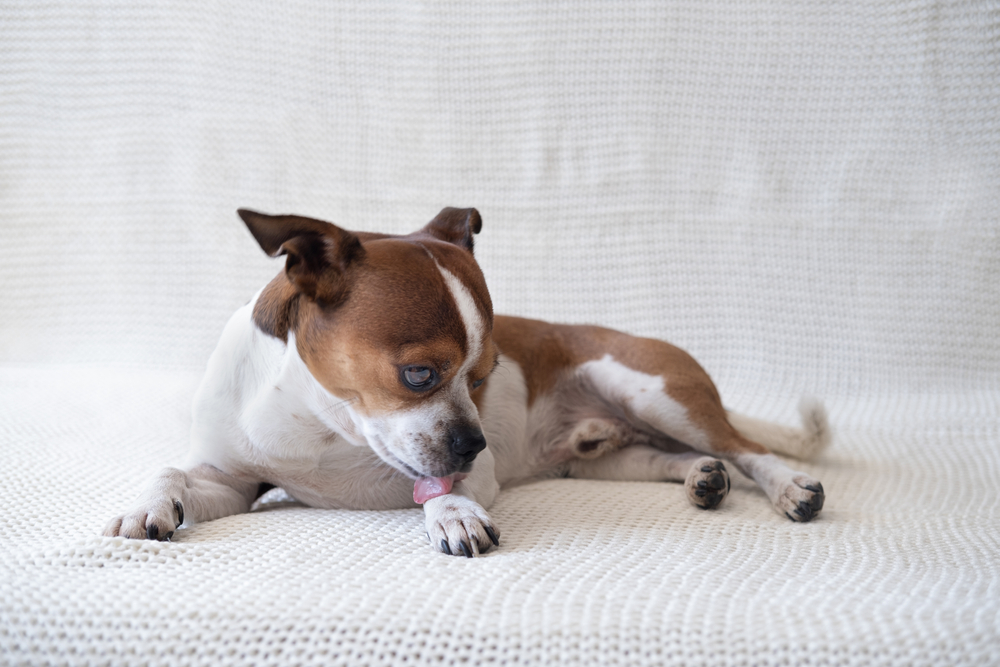In this article
If you have been cuddling with or smooching on your dog, you might have got a smell of something familiar. Something you can’t quite put your finger on. Or can you? That’s right. It smells like somebody just opened up a fresh bag of Fritos, so what’s the deal?
If you’ve recently realized that your dog’s feet smell like Fritos, you might be mildly concerned that this is a sign of a bigger issue. You are a wonderful pet parent for checking it out. This odd smell comes from the mixture of sweat, bacteria, and yeast on the paws.
So, in this article, we will explain where that smell comes from and how you can tell if it’s problematic or normal. So let’s dig in.

That Frito Paws Smell—What Is It?
First, that Frito smell you get a whiff of is usually completely normal. The smell comes from the mixture of sweat, bacteria, and yeast on the paws.
Dogs only sweat in certain parts of their bodies, and most sweat is released from their paw pads. The folds between the toes and pads are areas of increased moisture and reduced air circulation, making it the perfect place for bacteria and yeasts, normally present on the skin surface, to proliferate.
It’s often not problematic at all and is completely normal in most cases. However, it could be a different story if you notice any redness or irritation, or if the smell is overwhelming. If the bacteria or yeast overgrows too far out of control, you might notice signs that point to a bigger problem.
So, in short, the Frito paws smell itself is a very normal phenomenon. However, that doesn’t mean you shouldn’t look for other signs to ensure your pup is healthy and requires no medical care.


The 8 Possible Causes for Concern
1. Pododermatitis
Pododermatitis is a medical term used to describe inflammation of the skin of the paw. It can have many underlying causes, and the color, texture, and sometimes the smell of the dog paw will be different.
Unfortunately, many dogs with pododermatitis that is undiagnosed and untreated go on to develop complex bacterial infections, resulting in painful, swollen lumps or ulcerations. If you notice any signs like your dog licking their paws, swollen or red paws, or a marked increase in smell, get them checked out by your veterinarian sooner rather than later.
If your dog has an infection, the smell is a little worse than just the scent of Fritos. It generally smells more pungent and can be rotten, moldy, rancid, or sour smelling.
So, if you catch a whiff of something that strikes you as abnormal, it might be worth checking out. Check especially well in between each one of your pup’s toes to make sure there are no abscesses, redness, swelling, or irritation.
If you see any of these signs, it could very strongly indicate that your dog has a medical issue, and you should get it checked out by your vet so they can treat it appropriately.
Let’s explore one by one the possible causes.
2. Fungal/Bacterial Infections
If you notice an off smell, fungal or bacterial infections may just be the culprit—and usually are! These infections come from an overgrowth, typically of naturally occurring bacteria and/or yeasts on the skin. But it could also be contamination from soil or environmental microorganisms colonizing it.
As we mentioned above, many microbes need moisture-rich environments to thrive best. So, if your dog loves water or constantly has damp feet, it could really contribute to recurring infections. Also, it might affect your pup if they have long fur where moisture can sit without airing out.
Often, medicated antiseptic washes and topical ointments or creams can take care of these issues once your vet has diagnosed the problem.

3. Allergies
Also, if your dog has any kind of allergy, it can result in inflammation of the paws and other parts of the body. Not only can your dog be suffering from pesky food allergies, but they can also struggle with environmental allergies to things like grass, weeds, and other irritants.
- Itchy skin
- Recurring infections of the skin and ears
- Hair loss
- Red, inflamed skin
- Hives
- Excessive shedding
- Excessive paw licking
Allergies are unfortunately prevalent in dogs but can be difficult to pinpoint if triggers aren’t obvious. Your vet will need to rule out other skin conditions that look similar (such as parasites), and then might recommend food trials, skin tests, or other detection methods to find out what your dog is allergic to.
4. Underlying Health Conditions
If your pup has a more serious underlying health condition, this could also be behind unhealthy skin on the paws. Metabolic issues such as hypothyroidism, hyperadrenocorticism (Cushing’s disease), and hepatocutaneous syndrome can all cause a disruption in natural paw health and can lead to smells, cracking, irritation, and other skin issues.

5. Pododermatitis
Pododermatitis is inflammation of the skin of the paw. It can have many underlying causes, including allergies as we mentioned. Other potential causes for sore, inflamed feet include parasites, hormonal disease, and foreign bodies. Some dogs will have ‘conformational pododermatitis’ which typically occurs in heavy dogs with splayed feet and abnormal weight bearing. So often it affects obese dogs that have increased pressure on the feet.
Unfortunately, many dogs with pododermatitis that is undiagnosed and untreated go on to develop deep bacterial infections resulting in painful, swollen lumps. If you notice any signs of your dog licking their paws, swollen or red paws or a marked increase in smell, get them checked out by your veterinarian sooner rather than later.
6. Tumors
While rarer, tumors can develop in the paws, leading to irritation and smell. There are a variety of tumors that can affect dogs paws and so growths will vary in appearance and location. Always get any growth on your dog’s paws examined by your vet, they may want to sample or biopsy it before deciding on the best course of action.
7. Pemphigus Foliaceus
This autoimmune disease can cause nasty symptoms, including painful crusts and sores that can affect the paw pads.
As with any potential health issue, your vet can determine a diagnosis, care plan, and any required treatments.

8. Abrasion, Excessive Temperatures, or Chemical Irritation
The direct contact of your dog’s paws with chemicals, such as snow melt, or with extremely high or low temperatures can all cause damage and inflammation of their pad paws. Cracked, burned, or injured skin also becomes more susceptible to secondary infections.
If you’re concerned about your dog’s health we suggest you speak to a vet.
If you need to speak with a vet but can't get to one, head over to PangoVet. It's our online service where you can talk to a vet online and get the advice you need for your dog — all at an affordable price!

Should You Mask the Frito Smell?
For dogs with a corn chip smell from their otherwise healthy paws, as it’s not doing any harm, there’s really no reason to treat it or mask it with fragrance or other scents. In fact, adding fragrance can sometimes be irritating, truly leading to a problem that can be avoided otherwise.
However, regularly checking your dog’s paws and keeping them healthy and clean is essential to ensure nothing gets out of balance.


How to Keep Your Dog’s Feet Healthy
There are several ways you can ensure the paw health of your pooch and help to get rid of smelly dog feet! Some examples include:
Keeping Paws Dry
Because, the majority of the time, infections are caused by moisture trapped between the folds of the digital paw pads, it’s a good idea to keep your pets dry. If it has been particularly rainy, they might get extra moisture in their paw pads when going out to play or taking long walks. Also, remember the paws have sweat glands, so physical activity or excessive temperatures might be the culprit as well.
Trim Foot Fur
If your dog has long fur, it can play a contributing role to paw health. It is so easy for dander, moisture, and debris to get trapped in between the toes, resulting in irritation and bad smells. Even if the skin itself is not irritated, any of the gunk in between can really be putrid!
If this is the case, you can trim the fur in the paw pads using professional clippers. Just be careful and don’t do anything you’re not comfortable with. If you would rather, you can always visit a professional groomer to have your dog’s fur trimmed.

Cleaning Out Debris Between Toes
Regularly check your dog’s toes. If they have any dirt or debris buildup in between, make sure to remove it thoroughly. The buildup of gunk alone can cause an overgrowth of bacteria, leading to bad smells and poor hygiene.
Make sure that you use pet-friendly shampoo or wipes, as human products are not pH balanced for canines. This can cause irritation, worsening the already existing problem. There are tons of pet-friendly options on the market.
If you are looking for the perfect product to clean your dog's sensitive areas, Hepper's Wash Wipes are our recommendation, plus it's a great on-the-go option. These premium wipes are thick and durable enough for the toughest of paw messes, while still being soft enough to use on your dog's ears or eyes. Formulated with pet-friendly, hypoallergenic ingredients they are the ideal product for all dogs of all ages, skin conditions, or sensitivities.
At Dogster, we’ve admired Hepper for many years and decided to take a controlling ownership interest so that we could benefit from the outstanding designs of this cool pet company!

Conclusion
If you’ve made it to the end of this article and still aren’t completely convinced, don’t take our word for it! Discuss any concerns you might have about your dog’s feet with your vet. They can look them over and recommend any treatment or further testing.
Ultimately, corn chip-smelling paws are common and usually not concerning if your dog’s paws are otherwise healthy. So, even though this smell might bother you sometimes, it’s nothing to treat as it stands. So, deal with the smell of Fritos if you can!
See Also:
Featured Image Credit: Izemphoto, Shutterstock





















